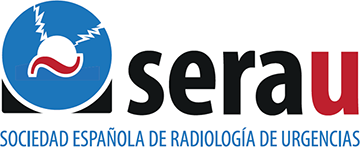Hospital: HOSPITAL MORALES MESEGUER.
Nº: C2019-199
Aut@r o Autores: A. Barceló Cárceles, I. Cases Susarte, J.M. Plasencia Martínez, A. García Chiclano, I. González Moreno, M.P. Lozano Ros.
Presentación
We present the case of a 49-year-old woman diagnosed with stage IV lung adenocarcinoma in 2018, with carcinomatous lung lymphagitis and liver metastases, under treatment with Pembrolizumab, receiving the third cycle on 16.1.2019. On 28.1.2019 he consulted in the Emergency Department due to an increase in her baseline dyspnea , accompanied by cough. He enters the Oncology service, with oxygen therapy and antibiotherapy, without improvement. She undergoes CT with iv contrast, where a “crazy paving” pattern is observed in the left lung in relation to immunotherapy toxicity as a first option, and signs of progression of the disease (focal liver lesions, and increased right pleural effusion and thickening). Her admission to the ICU was decided, with drainage of the right pleural effusion through thoracic tube placement. Despite oxygen therapy, the patient requires intubation. In the chest X-ray of control, the UCI service is informed that the inflated cuff has a transverse diameter of 2.8 cm (normal between 2 and 2.5 cm), and it produces distension of the tracheal wall, which is suspicious of tracheal laceration (1). In view of these findings and the immediate clinical worsening, the chest X-ray is repeated after deflating the cuff, showing subcutaneous emphysema, severe pneumomediastinum and bilateral pneumothorax, findings indicative of tracheal rupture. The subsequent evolution is a rapid tendency to hypotension and oliguria. In a situation of shock and refractory hypoxemia, the patient dies.
Discusión
The iatrogenic tracheal rupture is a rare but feared complication by the high morbidity and mortality, up to 42% published in some series(2). Associated factors are intubation in an emergency situation, hyperinflation of the orotracheal tube, or age greater than 50 years (1-2). In our case, the radiography shows a hyperinflated balloon (2.8 cm in diameter), which exceeded the pressure of the walls of the trachea, preceding the airleak signs. The most frequent radiological signs of tracheal rupture are the appearance of pneumothorax, pneumomediastinum and subcutaneous emphysema, as in our case (3)The preferred treatment of these injuries is surgical, however, in small and asymptomatic lesions, expectant management can be performed.
Conclusión
The iatrogenic tracheal rupture is a very rare but very serious complication. It can be promptly suspected from the chest X-ray whenever we know its manifestations.
Bibliografía
- Godoy M., Leitman B, de Groot P., Vlahos I., Naidich D. Chest Radiography in the ICU. Part 1. Evaluation of Airway, Enteric, and Pleural Tubes.American Journal of Roentgenology. 2012,198: 563-571. - Hofmann HS, Rettig G, Radke J, Neef H, Silber RE. Iat


